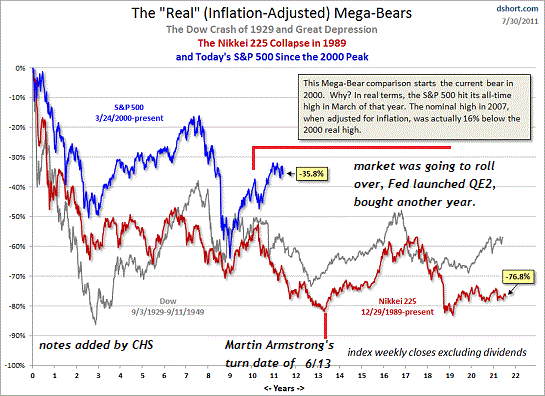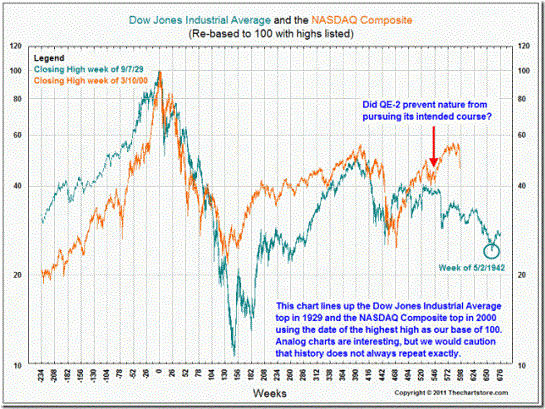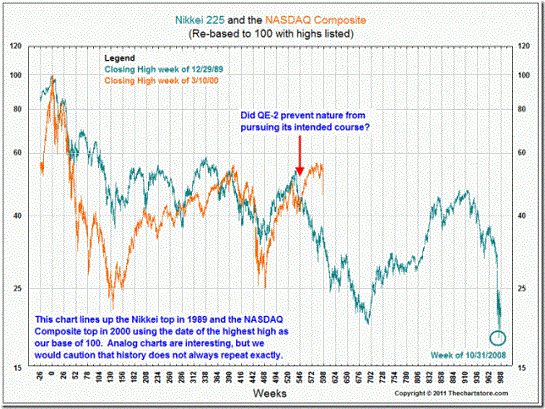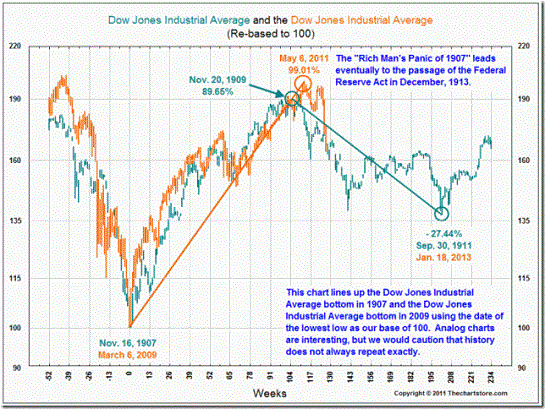And Off the Cliff We Go
INTERVIEW ALERT: Chris Martenson was kind enough to interview me last week; thepodcast and transcript are on ChrisMartenson.com. Thank you, Chris and Adam, for the opportunity to discuss relocalization and withdrawing capital from Wall Street.
Did the Federal Reserve's QE2 program last year simply push the inevitable stock market decline forward a few months? It would seem so. In Remind Us Again Why Anyone Should Own Stocks For the Next Two Years (August 3, 2011) and The Junkie in the Pool and False Idols: Faith in Wall Street and The Fed Has Has Eroded (August 10, 2011) I included a chart of the current S&P 500 plotted against the two Great Bear Markets of last century, the Great Depression-era Dow Jones Industrial Average (1929 crash) and the Nikkei stock market from 1989.
It certainly looked like all the Fed accomplished with its $600 billion QE2 was stave off the inevitable by a few months:
Courtesy of The Chart Store, here is more evidence that the Fed just pushed the day of reckoning forward a few months: the first charts the current NASDAQ market plotted over the Great Depression Dow, and the second plots the current NASDAQ over the post-1989 Nikkei market.
The similarity of the two Bear market progressions is uncanny. As Ron Greiss of the Chart Store notes on the chart, "Did QE2 prevent nature from pursuing its intended course?" Judging by the recent "unexpected" cascade in stock valuations, it seems the Fed has yet to learn that you can't fool Mother Nature for very long:
Once again it looks like the Fed's attempt to stave off the inevitable crash in stock market valuations was temporary rather than permanent:
This week we see the same game plan being worked once again: smash the U.S. dollar and juice the risk trade, as if the inevitable recalibration with reality can be staved off forever. Judging by these three charts, that recalibration will take about another two years.
Perhaps when the stock market reaches its inevitable (i.e. unmanipulated) true value some time in 2013, then the Fed's attempts to fool Mother Nature will be seen for what they are: catastrophic failures.
Here is a bonus chart, courtesy of The Chart Store, that overlays the current rally and collapse with the Dow's 1907 crash. The similarity is rather uncanny:
As we can see, The Fed's QE2 didn't change the future decline, it simply pushed it forward a few months: the current market has now caught up with the 1907 decline.
With inflation rising and the markets falling, just how effective do you reckon QE3 or any other gambit will be in staving off reality?
"There isn't a shrewder and more insightful observer of the chaotic, swirling American scene than Charles Hugh Smith. If you are having trouble making sense of your culture, please buy this book!"
If you have some doubts about Wall Street's permanently Bullish "guidance," you might be interested in my new book An Unconventional Guide to Investing in Troubled Times, now available in Kindle ebook format. You can read the ebook on any computer, smart phone, iPad, etc.Click here for links to Kindle apps and Chapter One.
Order Survival+: Structuring Prosperity for Yourself and the Nation (free bits) (Mobi ebook) (Kindle) or Survival+ The Primer (Kindle) or Weblogs & New Media: Marketing in Crisis (free bits) (Kindle) or from your local bookseller. Of Two Minds Kindle edition: Of Two Minds blog-Kindle
The Fed has yet to learn that you can't fool Mother Nature for very long, and its punishing lesson has just begun.



INTERVIEW ALERT: Chris Martenson was kind enough to interview me last week; thepodcast and transcript are on ChrisMartenson.com. Thank you, Chris and Adam, for the opportunity to discuss relocalization and withdrawing capital from Wall Street.
I am taking a break from posting and email. As I won't be reading correspondence for a number of days, I won't be able to reply to emails. Thank you for your understanding.
What others are saying about An Unconventional Guide to Investing in Troubled Times:
--James Howard Kunstler, author of The Long Emergency and the World Made By Hand novels
"Less 'how-to' than how to think, An Unconventional Guide to Investing in Troubled Times is the perfect antidote to the smoke-and-mirrors groupthink that runs rampant on Wall Street. Chock full of insights on accumulating and preserving wealth in a rapidly-changing world, Charles Hugh Smith's latest book is a 'must have.'"
--Michael Panzner, author of Financial Armageddon and When Giants Fall
"For anyone seeking an original, eye-opening, unvarnished and practical approach to the real New Normal, and the capital markets that accompany it, Charles Hugh Smith, one of the very few voices in the noisy wilderness of the financial Internet worth listening to, has just released this must read book for anyone who wishes to learn about the other, and more importantly correct, side of the story."
--Tyler Durden, Zero Hedge
"A masterful synthesis of essential insight and practical guidance. This Unconventional Guide explains why our economy and financial markets have reached a level of unsustainable systemic risk -- and how understanding the nature of the forces at play enables savvy strategies for securing 'wealth' (of all kinds) as the inevitable dénouement unfolds. Few authors write with the intelligence and heart that Charles does; fewer books empower the reader more to face the certain changes in our future with confidence."
--Chris Martenson & Adam Taggart, proprietors of ChrisMartenson.com

Readers forum: DailyJava.net.
My new book An Unconventional Guide to Investing in Troubled Times is available in Kindle ebook format. You can read the ebook now on any computer, smart phone, iPad, etc. Click here for more info about Kindle apps and the book.Thank you, Sandra D. ($20), for your wondrously generous contribution to this site -- I am greatly honored by your support and readership. Thank you, Lawrence M. ($20), for your extremely generous contribution to this site -- I am greatly honored by your support and readership.



























